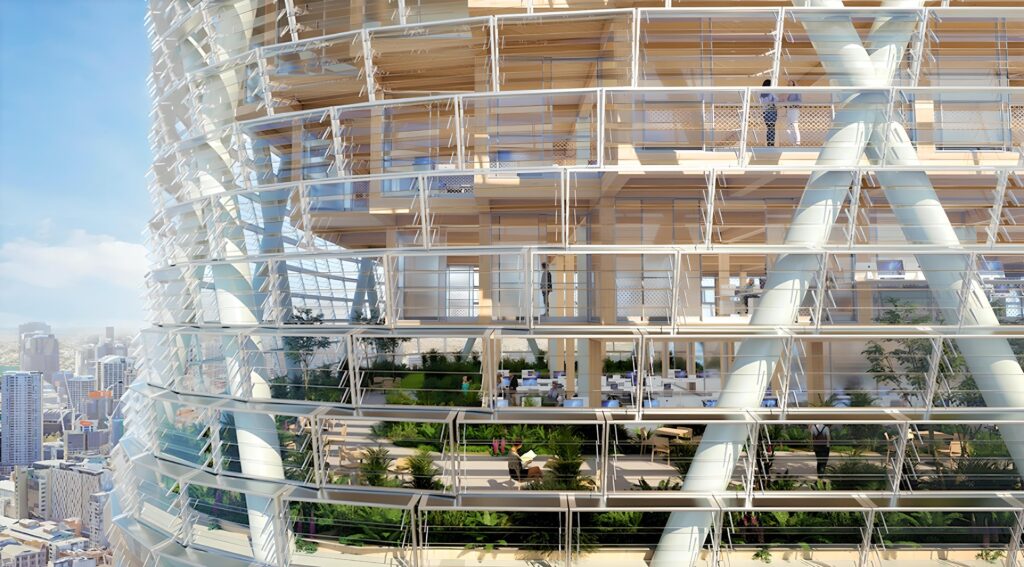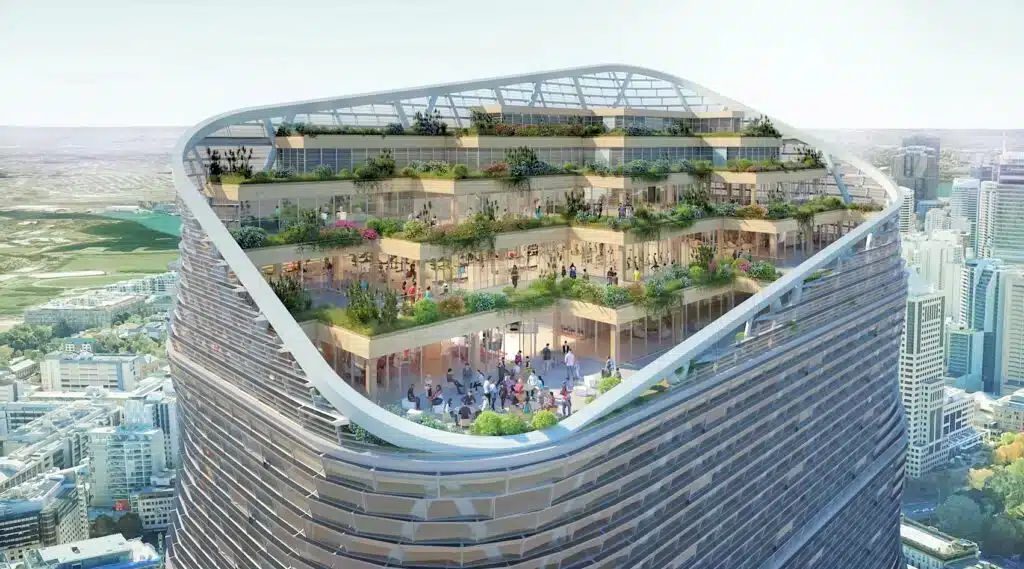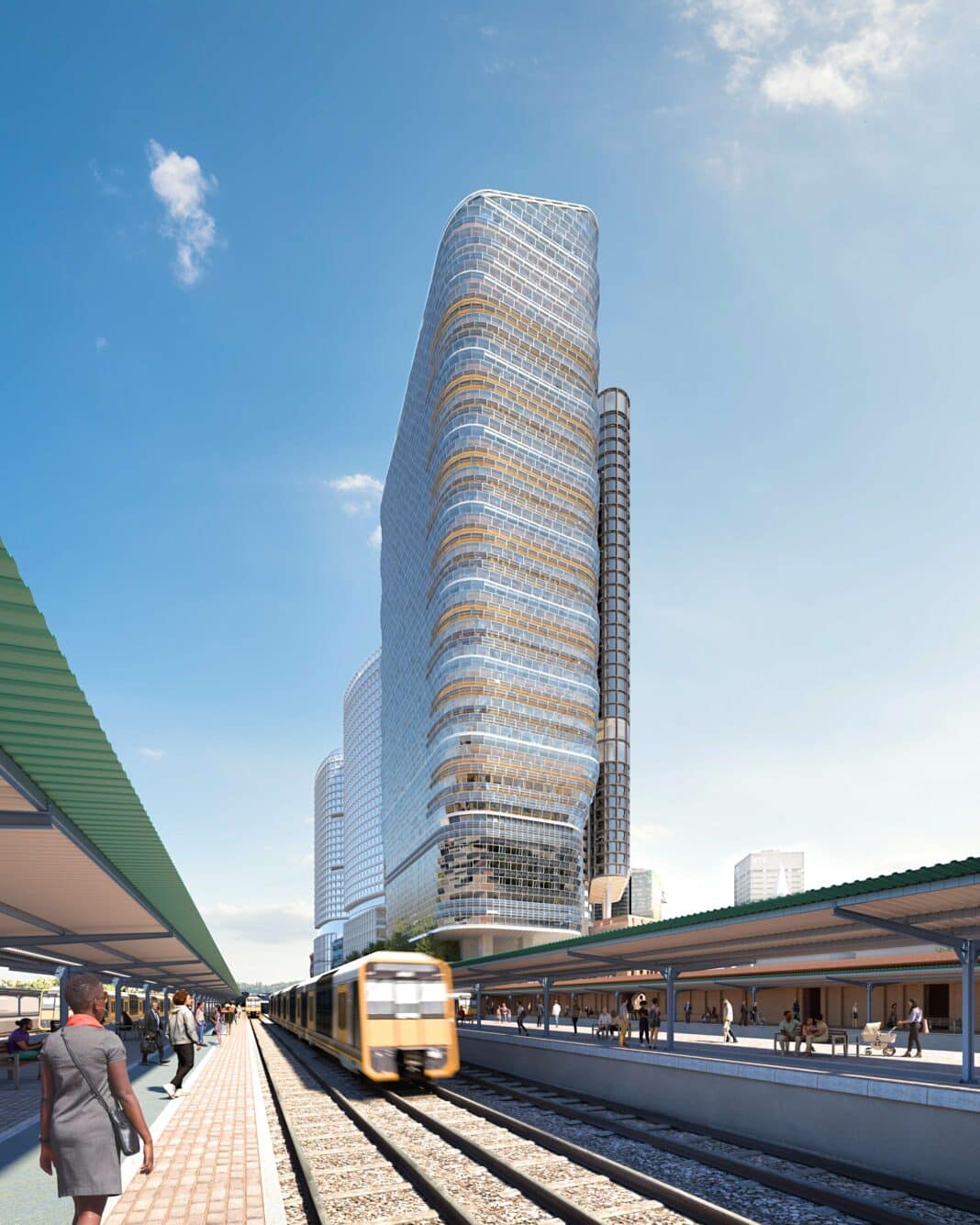The world’s largest hybrid building – described as “a timber building inside a much, much larger building,” has now “broken the back on the most technical, structural phase of its build” with “the hybrid timber approach allowing (the developers) to bring the building up quicker and get the facade on quicker than a more traditional build.”
That is according to Peter Morely, the Dexus project director responsible for the $1.45 billion project, who spoke exclusively to Phil Bartscht from the Urban Developer about the massive project today:
“That’s because we’re jumping up five levels every time, and while we’re going up, we’re coming back and infilling with the timber within each of those five-storey zones.”
Dubbed the timber habitats, the seven four-storey infills (making up 21 of the building’s 39 total floors) each comprise three cross-laminated timber flooring systems sandwiched between steel-and-concrete mega floor plates. These are all built over a seven-floor concrete podium and structural steel exoskeleton, and fan out from the building’s steel-and-concrete core as it gets higher and higher.

In August, Wood Central reported that Tim Allen, one of the Taylor Thomson Whitting (TTW) structural engineers working on the project, explained how the hybrid construction system worked: “The timber floors connect the concrete floors via drag straps, adding that the innovative lateral design is one of the most advanced anywhere in the world.
“Why build a 39-storey building partly out of timber?” Mr Allen said, “It comes down to using the right timber for the right application.”
Starting next year, Austrian giants Stora Enso and Wieharg will supply thousands of cubic metres of cross-laminated timber and glulam beams, which will help construct more than 21 floors of cross-laminated timber flooring and glulam beams. With 2,000 square metre floor plates, Wood Central understands that a massive amount of cross-laminated timber will be used in the plyscraper – substituting vast quantities of concrete and steel traditionally used to construct skyscrapers.
The latest update comes from Joe Karten, Head of Sustainability for the project’s principal contractor (Built), who said the “aspiration of (Atlassian) was to create a lighthouse to effectively change the standard that we expect for buildings.”
Atlassian Central is co-owned by Dexus and Atlassian, with Built and Japanese asset manager Obayashi – appointed as builders – confirming that the building remains “on schedule” for a grand opening in 2026.
“What Atlassian has done has set the bar high at a global level. And we’re going to see a lot of action around buildings that tackle embodied carbon in a real and authentic way,” Mr Karten told the AFR’s Tech Zero podcast, confirming the tower will accommodate 5,000 occupants, including Atlassian, who will move in early 2027.
“They’ve [Atlassian] made no secret that they didn’t require the standard property developer margins on that project,” Mr Karten said, adding that “they invested some extra money to create a real icon of a project. Now, that’s invaluable because attracting talent—we know in tech, the war for talent is fierce.”

At the same time that the Atlassian Central Tower is rising over Sydney’s Central Train Station, advanced plans are afoot for the 55-storey $1.8b ‘Halo’ development – set to become the world’s tallest timber building with the backing of the Lendlease development arm.
The site for ‘Halo’ is a short walk from the Atlassian Central Tower. It spans 15-25 Hunter St and 105-107 Pitt St and is in Sydney’s core precinct, dominated by the financial, legal, property, and tech sectors.
- To learn more about the Atlassian Central Tower, click here for the Urban Developer’s exclusive interview with Peter Morely.






